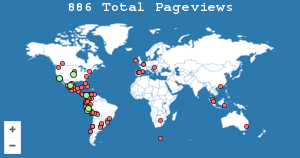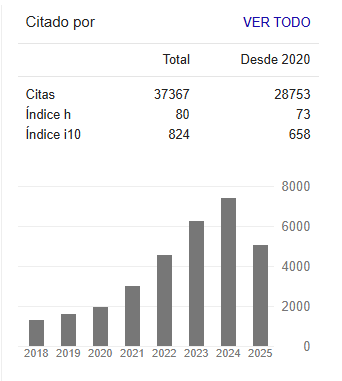Ranking bibliométrico internacional Scimago: una realidad para las universidades peruanas
Resumen
La investigación científica se ha convertido en uno de los temas más importantes para las universidades, especialmente para el Perú, con avances significativos en términos de producción científica. Este artículo tiene como objetivo determinar la posición que ocupan las universidades más representativas del Perú frente a las universidades de Latinoamérica, según el Ranking Institucional Scimago. La metodología se fundamenta en la Bibliometría, el diseño es cuantitativo con el análisis documental recopilado de la literatura nacional e internacional. Se ha obtenido que dentro de los 10 primeros lugares en el Ranking de Latinoamérica, no aparece ninguna universidad peruana; sin embargo desde el puesto 37 hacia adelante aparecen las primeras universidades, siendo la primera la Universidad Cayetano Heredia. En conclusión, es un gran avance para las universidades peruanas aparecer en el ranking general de los países de Latinoamérica; si bien es cierto no en los primeros lugares, pero si con una presencia ascendente, lo que demuestra su interés investigativo.
Citas
Barriga, S. F., Barbón, O. G., y Buenaño, C. V. (2018). Impacto de la producción científica de un programa experiencial para la investigación dirigidos a docentes universitarios. Form Univ., 11(3), 41-8.
Bastidas Jiménez, M., y Benites Medina, R. (2016). Incidencia de la motivación en la producción científica institucional. Revista Retos, 6(11), 65-87. https://doi.org/10.17163/ret.n11.2016.05
Becher, T. (1989). Academic tribes and territories: Intellectual enquiry and the cultures of disciplines. Bristol: Society for Research into Higher Education and Open University Press.
Bordons, M., Fernández-Bajón, M. y Gómez-Caridad, I. (2002). “Advantages and limitations in the use of impact factor measures for the assessment of research performance”. Scientometrics, 53(2), 195-206. https://doi.org/10.1023/A:1014800407876
Bornmann, L. (2017). Measuring impact in research evaluations: a thorough discussion of methods for, effects of and problems with impact measurements. Higher education, 73(5), 775-787. https://doi.org/10.1007/s10734-016-9995-x
Bornmann, L., Gralka, S., De-Moya-Anegón, F., y Wohlrabe, K. (2020). Efficiency of universities and research-focused institutions worldwide: An empirical DEA investigation based on institutional publication numbers and estimated academic staff numbers. CESifo working paper No. 8157 2020. https://ssrn.com/abstract=3555584
British Council. (2016). La reforma del sistema universitario peruano: Internacionalización, avance, retos y oportunidades.
Cáceres Castellanos, G. (2014). La importancia de publicar los resultados de Investigación. Revista Facultad de Ingeniería, 23(37), 7–8. http://www.scielo.org.co/scielo.php?script=sci_arttext&pid=S0121-11292014000200001
Celi, A. (2014). El rol docente en la universidad: su participación en la promoción de la investigación académica. Rev Derecho Univ Montev., 3(26), 73-81.
Chen, P., Xie, H., Maslov, S., y Redner, S. (2007). Finding scientific gems with google’s pagerank algorithm. Journal of Informetrics, 1(1), 8-15. https://doi.org/10.1016/j.joi.2006.06.001
Codina-Canet, M. A., Olmeda-Gómez, C., & Perianes-Rodríguez, A. (2013). Análisis de la producción científica y de la especialización temática de la Universidad Politécnica de Valencia. Scopus (2003-2010). Revista Española De Documentación Científica, 36(3), e019. https://doi.org/10.3989/redc.2013.3.942
Consejo Nacional de Ciencia Tecnología e Innovación Tecnológica (2019), Madrid – Lima, https://www.portal.concytec.gob.pe
Cox, C. y Courad, H. (1990). Autoridades y Gobierno en la Universidad chilena 1950 – 1989. Categorías y Desarrollo Histórico, en C. Cox (ed.): Formas de Gobierno en la Educación Superior: Nuevas perspectivas, Santiago de Chile, FLACSO, pp. 51-109.
Cujía Berrio, S., Jiménez Cárdenas, M., & Pitre, R. (2017). Producción científica del docente investigador de las universidades públicas del departamento de la guajira. Saber, Ciencia y Libertad, 12(1), 246–254. https://doi.org/10.18041/2382-3240/saber.2017v12n1.1476
Dáher, N. J., Panuncio, A., y Hernández, N. M. (2018). La investigación científica: una función universitaria a considerar en el contexto universitario. Edumecentro, 10(4). http://scielo.sld.cu/scielo.php?script=sci_arttext&pid=S2077-28742018000400011
Delgado, L. (2016). Universidad e Investigación. Revista Estomatológica Herediana, 26(2), 61-2. http://www.scielo.org.pe/scielo.php?script=sci_arttext&pid=S1019-43552016000200001
Elsevier R & D Solutions. (2015). Case Study Scopus. https://www.elsevier.com/esmx/solutions/scopus
Eysenbach, G. (2011). Can tweets predict citations? Metrics of social impact based on twitter and correlation with traditional metrics of scientific impact. Journal of Medical Internet Research, 13 (4), e123. https://pubmed.ncbi.nlm.nih.gov/22173204/
Figueira, I., Jacques, R., y Leta, J. (2003). A comparison between domestic and international publications in brazilian psychiatry. Scientometrics, 56(3), 317-327.
Forero-Jiménez, M. Y. (2019). Modelo de responsabilidad social universitaria: una propuesta para las instituciones colombianas. Revista de Investigación, Desarrollo e Innovación, 9(2), 249-260. https://doi.org/10.19053/20278306.v9.n2.2019.9160
Galvez, C. y Moya-Anegón, F. (2007). Standardizing formats of corporate source data. Scientometrics, 70(1), 3-26. https://doi.org/10.1007/s11192-007-0101-0
Gibbs, W. W. (1995). Lost science in the third world. Scientific American, 273, 92-99. https://www.scientificamerican.com/article/lost-science-in-the-third-world/
González-Pereira, B., Guerrero-Bote, V., y Moya-Anegón, F. (2010). A new approach to the metricof journals’scientific prestige: The SJR indicator. Journal of Informetrics, 4(3), 379-391. https://doi.org/10.1016/j.joi.2010.03.002
Guerrero Bote, V. P., Olmeda-Gómez, C., y Moya-Anegón, F. (2013). Quantifying the benefits of international scientific collaboration. Journal of the American Society for Information Science and Technology, 64(2), 392-404. https://doi.org/10.1002/asi.22754
Guerrero-Bote, V. P., y Moya-Anegón, F. (2012). A further step forward in measuring journals’scientific prestige: The SJR2 indicator. Journal of Informetrics, 6(4), 674-688. https://doi.org/10.1016/j.joi.2012.07.001
Guerrero-Bote, Vicente P., Sánchez-Jiménez, R., y De-Moya-Anegón, F. (2019). The citation from patents to scientific output revisited: A new approach to the matching Patstat / Scopus”. El profesional de la información, 28(4), e280401. https://doi.org/10.3145/epi.2019.jul.01
Herman, Eti y David Nicholas. 2019. “Scholarly reputation building in the digital age: An activity-specific approach. Review article”. El Profesional de la Información, 28(1), e280102. https://doi.org/10.3145/epi.2019
Hull, D., Pettifer, S. R., y Kell, D. B. (2008). Defrosting the digital library: Bibliographic tools for the next generation web. Plos Computational Biology, 4(10), e1000204.
Ingwersen, P. (2000). The international visibility and citation impact of scandinavian research articles in selected social science fields: The decay of a myth. Scientometrics, 49(1), 39-61. https://www.researchgate.net/publication/242916383_The_International_Visibility_and_Citation_Impact_of_Scandinavian_Research_Articles_in_Selected_Social_Science_Fields_The_Decay_of_a_Myth
Katz, J. S. (1999). The self-similar science system. Research Policy, 28(5), 501-517.
King-Domínguez, A., Llinas-Audet, X., y Améstica-Rivas, L. (2019). Rankings universitarios como medida de calidad: análisis comparado en Latinoamérica. Revista Venezolana de Gerencia, 23(Edición Especial 1), 218-237. https://doi.org/10.37960/revista.v23i1.24465
Lavalle, C., y de Nicolas, V. L. (2017). Peru and its new challenge in higher education: Towards a research university. PLOS ONE, 12(8), 1-12. https://doi.org/10.1371/journal.pone.0182631
Ley 30220. (2014). Ley Universitaria. Lima. https://www.sunedu.gob.pe/wp-content/uploads/2017/04/Ley-universitaria-30220.
Leydesdorff, L. (2009). How are new citation-based journal indicators adding to the bibliometric toolbox? Journal of the American Society for Information Science and Technology, 60(7), 1327-1336.
Leydesdorff, L. y Bensman, S. (2006). Classification and powerlaws: The logarithmic transformation. Journal of the American Society for Information Science and Technology, 57(11), 1470-1486. https://doi.org/10.1002/asi.20467
Moed, H. F. (2005). Citation analysis in research evaluation. Springer Netherlands.
Moed, H. F. (2009). “New developments in the use of citation analysis in research evaluation”. Archivum immunologiae et therapiae experimentalis, 57(13). https://doi.org/10.1007/s00005-009-0001-5
Moed, H. F. (2015). “Multidimensional assessment of scholarly research impact”. Journal of the Association for Information Science and Technology, 66(10), 1988-2002. https://doi.org/10.1002/asi.23314
Monteza-Arbulú, C. (2014). Modelo de gestión de la investigación y nivel de desarrollo de la investigación universitaria. UCV-Hacer. Revista de Investigación y Cultura, 3(2). https://www.redalyc.org/pdf/5217/521751976008.pdf
Moya-Anegón, F. (2012). Liderazgo y excelencia de la ciencia española. El Profesional de la Información, 21(2), 125-128. https://doi.org/10.3145/epi.2012.mar.01
Newman, M. (2003). The structure and function of complex networks. Siam Review, 45(2), 167-256.
Olssen, M. y Peters, M. A. (2005). Neoliberalism, higher education and the knowledge economy: From the free market to knowledge capitalism. Journal of Education Policy, 20(3), 313-345. https://doi.org/10.1080/02680930500108718
Orduña Malea, E. (2011). Propuesta de un modelo de análisis red informétrico multinivel para el estudio sistémico de las universidades españolas (2010). [Tesis Doctoral. Universidad Politécnica de Valencia, Valencia, España].
Pajić, D. (2015). On the stability of citation-based journal rankings. Journal of Informetrics, 9(4),990-1006. https://doi.org/10.1016/j.joi.2015.08.005
Paredes-Chacín, A. J., Inciarte González, A., y Walles-Peñaloza, D. (2020). Educación superior e investigación en Latinoamérica: Transición al uso de tecnologías digitales por Covid-19. Revista de Ciencias Sociales (Ve), XXVI(3), 98-117. https://doi.org/10.31876/rcs.v26i3.33236
Piedra, Y., y Martínez, A. (2007). Producción científica. Ciencias de la Información, 38(3), 33-8. https://www.redalyc.org/articulo.oa?id=181414861004
Ren, S., y Rousseau, R. (2002). International visibility of chinese scientific journals. Scientometrics, 53(3), 389-405.
Salager-Meyer, F. (2008). Scientific publishing in developing countries: Challenges for the future. Journal of English for Academic Purposes, 7(2), 121-132. https://doi.org/10.1016/j.jeap.2008.03.009
Santiago de Chile: Universidad Politécnica de Cataluña.
SCImago Research Group. (2019a). SIR Methodology. General Considerations. Recuperado de http://Scimagoir.com/methodology.php
SCImago Research Group. (2019b). SCImago Journal and Country Rank. http://Scimagojr.com
Spinak, E. (1996). Los análisis cuantitativos de la literatura científica y su validez para juzgar la producción latinoamericana. Boletín de la Oficina Sanitaria Panamericana, 120(2), 139-145.
Spinak, E. (2001). Indicadores cienciométricos. ACIMED, 9(4). http://scielo.sld.cu/scielo.php?script=sci_arttext&pid=S1024-94352001000400007
Suárez, W., y Díaz, J. (2014). Gestión de la investigación en la universidad pública venezolana. Telos. Revista de Estudios Interdisciplinarios en Ciencias Sociales, 16(1), 135–156. http://ojs.urbe.edu/index.php/telos/article/view/2207
Torres-Salinas, D. (2011). ¿Cómo publicar en revistas científicas de impacto? Seminario ‘Visibilidad y accesibilidad a la accesibilidad a la producción científica’. Navarra: Biblioteca Universidad de Navarra. http://ec3noticias.blogspot.com/2011/05/como-publicar-en-revistas-cientificas.html
Universidad Politécnica de Cataluña, y Centro Interuniversitario de Desarrollo. (2007). Acreditación y dirección estratégica para la calidad en las universidades.
Valles-Coral, M. A. (2019). Modelo de gestión de la investigación para incrementar la producción científica de los docentes universitarios del Perú. Revista de Investigación, Desarrollo e Innovación, 10(1), 67-78. http://www.scielo.org.co/scielo.php?script=sci_arttext&pid=S2027-83062019000200067
Van-Raan, A. F. J. (2004). Measuring science. In: Moed, Henk F.; Glänzel, Wolfgang; Schmoch, Ulrich. Handbook of quantitative science and technology research. Dordrecht: Springer.
Wagner, C. S. (2008). The new invisible college: Science for development. Brookings Institution Press.
Waltman, L. (2016). A review of the literature on citation impact indicators. Journal of informetrics, 10(2), 365-391. https://doi.org/10.1016/j.joi.2016.02.007
Wilsdon, J., Allen, L., Belfiore, E., Campbell, P., Curry, S., Hill, S., Jones, R., Kain, R., Kerridge, S., Thelwall, M., Tinkler, J., Viney, I., Wouters, P., Hill, J., y Johnson, B. (2015). The Metric Tide: Report of the independent review of the role of metrics in research assessment and management. https://doi.org/10.13140/RG.2.1.4929.1363

Esta obra está bajo licencia internacional Creative Commons Reconocimiento-NoComercial-CompartirIgual 4.0.








.png)






























